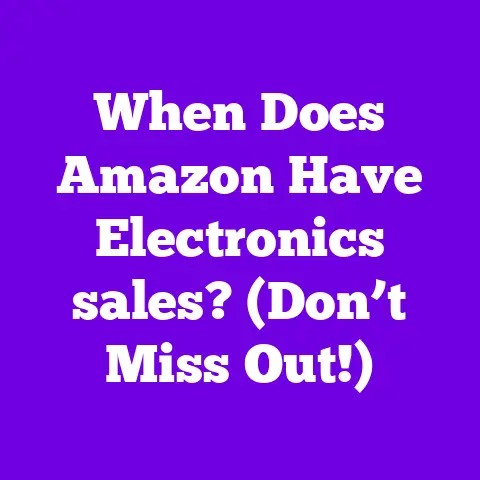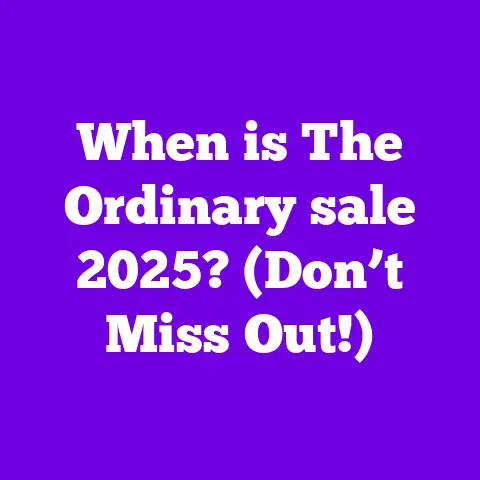Biggest USA sale in 2025? (Don’t Miss These Dates!)
Remember the frenzy surrounding the latest Marvel movie release?
The lines stretching around the block, the sold-out merchandise, the collective online buzz?
That’s a microcosm of the consumer energy that erupts during major sales events in the USA.
It’s not just about discounts; it’s a cultural phenomenon, a shared experience, a moment in time where desire and opportunity collide.
Sales events in the USA aren’t just about grabbing a bargain; they’re woven into the fabric of our society.
They mark seasons, celebrate holidays, and reflect our evolving desires and aspirations.
From the adrenaline-fueled chaos of Black Friday to the digital deals of Cyber Monday, these events offer a glimpse into the heart of American consumerism.
In this article, I’ll take you on a journey through the landscape of sales events in the USA, focusing on what you can expect in 2025.
We’ll explore key dates, delve into the historical context that shapes these events, and examine the fascinating interplay between pop culture and consumer trends.
Get ready to mark your calendars and prepare for a year of savvy shopping!
Section 1: Historical Context of Sales Events in the USA
The evolution of sales events in the USA is a story of adaptation and innovation.
What started as post-Thanksgiving clearance sales has transformed into a year-round phenomenon fueled by technology and shaped by cultural trends.
Black Friday, the day after Thanksgiving, is perhaps the most iconic example.
Its origins can be traced back to the 1950s, but the term “Black Friday” gained prominence in the 1960s to describe the chaotic traffic jams and crowded stores that followed Thanksgiving Day.
Over time, retailers recognized the potential and began offering increasingly enticing deals, turning Black Friday into the shopping extravaganza we know today.
Cyber Monday, a more recent addition to the sales calendar, emerged in the early 2000s as online retailers sought to capitalize on the growing popularity of e-commerce.
The term was coined in 2005 by Shop.org, a division of the National Retail Federation (NRF), to encourage people to shop online.
According to the NRF, Cyber Monday 2023 saw a record $12 billion in online sales, highlighting the event’s significance in the digital age.
Memorial Day sales have a more somber origin, honoring those who have died serving in the U.S.
military.
Retailers often offer discounts on items related to outdoor activities, home improvement, and summer apparel, aligning with the holiday’s focus on remembrance and celebration of freedom.
These events haven’t evolved in a vacuum.
They’ve been shaped by cultural moments and pop culture phenomena.
Remember the Tickle Me Elmo craze of 1996?
The Furby frenzy of 1998?
These were prime examples of how a popular toy, fueled by media hype, could drive shoppers into a frenzy during the holiday season.
Even more recently, the release of the first Star Wars movie since 2005, “The Force Awakens,” in December 2015, not only broke box office records but also spurred a surge in Star Wars-themed merchandise sales during the holiday season.
Retailers capitalized on the hype, offering exclusive products and promotions that tapped into the collective excitement surrounding the film.
The rise of social media has also played a significant role in shaping consumer expectations.
Influencers and viral marketing campaigns can create instant demand for specific products, leading to sell-outs and long lines during sales events.
The power of a well-placed TikTok video or a celebrity endorsement can’t be underestimated.
Section 2: Key Sales Dates for 2025
Let’s dive into the major sales events you should be aware of in 2025.
I’ll break down each event, highlighting its significance, potential pop culture tie-ins, and predicted trends.
New Year Sales (January 1, 2025)
- Significance: A chance to snag post-holiday clearance deals and start the year with a fresh slate of discounted items.
Many retailers are looking to clear out excess inventory from the holiday season. - Pop Culture Tie-In: Think of the “New Year, New Me” trope often depicted in movies and TV shows.
This cultural idea of self-improvement resonates with consumers looking to upgrade their wardrobes, fitness equipment, or home goods. - Predicted Trends: Expect to see discounts on winter apparel, fitness equipment, and home organization products.
The focus will likely be on products that support New Year’s resolutions. -
Valentine’s Day Sales (February 14, 2025)
-
Significance: A romantic holiday that drives sales in jewelry, flowers, chocolates, and experiences.
It’s a significant opportunity for retailers to tap into the emotions associated with love and affection. - Pop Culture Tie-In: Romantic comedies and love songs dominate the media landscape in the weeks leading up to Valentine’s Day.
Retailers often use these cultural references in their advertising campaigns. - Predicted Trends: Personalized gifts, experiences (like spa days or romantic getaways), and sustainable products are expected to be popular.
-
Memorial Day Sales (May 26, 2025)
-
Significance: The unofficial start of summer, Memorial Day sales are a great time to find deals on outdoor gear, appliances, and furniture.
- Pop Culture Tie-In: Memorial Day is often depicted in movies and TV shows as a time for barbecues, pool parties, and outdoor recreation.
- Predicted Trends: Expect discounts on patio furniture, grills, swimwear, and travel packages.
Home improvement retailers will also likely offer promotions on paint, gardening supplies, and other items related to outdoor projects. -
Independence Day Sales (July 4, 2025)
-
Significance: Celebrating American independence, this holiday is associated with sales on patriotic-themed merchandise, outdoor activities, and summer essentials.
- Pop Culture Tie-In: Parades, fireworks displays, and patriotic music are all integral parts of the Independence Day celebration.
- Predicted Trends: Discounts on American flag-themed apparel, grilling equipment, and outdoor games are expected.
Travel packages to national parks and historical sites may also be popular. -
Back-to-School Sales (August 2025)
-
Significance: A major shopping season for families with children, back-to-school sales offer discounts on school supplies, clothing, electronics, and dorm room essentials.
- Pop Culture Tie-In: Back-to-school advertising often features images of students preparing for the new school year, highlighting the excitement and anticipation associated with this time of year.
- Predicted Trends: Expect discounts on laptops, tablets, backpacks, clothing, and school supplies.
Retailers may also offer promotions on software and online learning resources. -
Labor Day Sales (September 1, 2025)
-
Significance: Marking the end of summer, Labor Day sales are a good time to find deals on fall apparel, home goods, and appliances.
- Pop Culture Tie-In: Labor Day is often associated with barbecues, picnics, and other outdoor activities.
- Predicted Trends: Discounts on fall clothing, home decor, and appliances are expected.
Travel packages to fall foliage destinations may also be popular. -
Black Friday (November 28, 2025)
-
Significance: The biggest shopping day of the year, Black Friday is known for its doorbuster deals and long lines.
- Pop Culture Tie-In: Black Friday has been depicted in countless movies and TV shows, often portraying the chaotic scenes and competitive shoppers.
- Predicted Trends: Expect discounts on electronics, appliances, clothing, and toys.
Online shopping will continue to play a major role, with many retailers offering exclusive deals through their websites and mobile apps. -
Cyber Monday (December 1, 2025)
-
Significance: The online counterpart to Black Friday, Cyber Monday offers discounts on a wide range of products, from electronics to clothing to travel.
- Pop Culture Tie-In: Cyber Monday is often associated with the convenience of online shopping, allowing consumers to avoid the crowds and lines of Black Friday.
- Predicted Trends: Expect discounts on electronics, clothing, and travel packages.
Mobile shopping will continue to grow in popularity, with many consumers using their smartphones and tablets to make purchases. -
Holiday Sales Season (December 2025)
-
Significance: The entire month of December is a prime shopping season, with retailers offering discounts on gifts, decorations, and holiday-themed merchandise.
- Pop Culture Tie-In: Holiday movies, music, and traditions play a major role in shaping consumer behavior during this time of year.
- Predicted Trends: Expect discounts on toys, electronics, clothing, and home decor.
Personalized gifts and experiences will also be popular.
- Significance: A chance to snag post-holiday clearance deals and start the year with a fresh slate of discounted items.
Section 3: The Cultural Impact of Sales Events
Major sales events are more than just opportunities to save money; they reflect broader cultural trends in American society.
They reveal our aspirations, our anxieties, and our shared experiences.
The rise of social media has profoundly impacted consumer behavior around these sales events.
Platforms like Instagram, TikTok, and YouTube have become powerful marketing tools, allowing brands to reach consumers directly and create a sense of urgency and excitement.
Influencers play a crucial role in shaping consumer preferences and driving sales.
A well-placed product review or a sponsored post can generate significant demand, leading to sell-outs and long lines.
The power of social media is undeniable, and retailers are increasingly leveraging these platforms to maximize their sales during major events.
Consider the example of Glossier, a beauty brand that has built a cult following through its social media presence.
Glossier’s Instagram account features user-generated content, product tutorials, and behind-the-scenes glimpses into the company’s culture.
This authentic and engaging approach has resonated with consumers, driving sales and creating a loyal customer base.
Another example is the rise of “dupes,” or affordable alternatives to popular products.
Social media influencers often share videos comparing dupes to their more expensive counterparts, helping consumers save money without sacrificing quality.
This trend reflects a growing desire for value and affordability, particularly among younger consumers.
Sales events also reflect our cultural values and priorities.
For example, the increasing popularity of sustainable products and ethical brands reflects a growing awareness of environmental and social issues.
Consumers are increasingly seeking out products that are made with sustainable materials, produced in fair labor conditions, and packaged in eco-friendly materials.
Section 4: Future Predictions and Trends
Looking ahead, the future of retail and sales is likely to be shaped by technological advancements, changing consumer preferences, and a growing emphasis on sustainability.
Augmented reality (AR) shopping experiences are poised to transform the way we shop.
Imagine being able to virtually “try on” clothes or “place” furniture in your home before making a purchase.
AR technology can enhance the shopping experience, making it more interactive, engaging, and personalized.
AI-driven personalization will also play a major role in shaping the future of retail.
AI algorithms can analyze vast amounts of data to understand consumer preferences, predict future purchases, and deliver personalized recommendations.
This level of personalization can lead to increased sales and customer loyalty.
Sustainability trends will continue to gain momentum, with consumers increasingly seeking out eco-friendly products and brands.
Retailers will need to adapt to this trend by offering sustainable alternatives, reducing waste, and promoting ethical sourcing practices.
Consider the pop culture narratives that envision the future of shopping.
In the movie “Minority Report,” consumers are targeted with personalized advertisements based on their biometric data.
While this scenario may seem far-fetched, it highlights the potential for technology to personalize the shopping experience in increasingly sophisticated ways.
Another example is the concept of “metaverse commerce,” where consumers can shop for virtual goods and experiences in immersive digital environments.
While the metaverse is still in its early stages, it has the potential to revolutionize the way we shop and interact with brands.
Conclusion
As we look ahead to 2025, it’s clear that sales events in the USA will continue to be a major cultural phenomenon.
From the historical significance of Black Friday to the digital deals of Cyber Monday, these events offer a glimpse into the heart of American consumerism.
By understanding the key sales dates, the historical context that shapes these events, and the interplay between pop culture and consumer trends, you can become a more informed and savvy shopper.
So, mark your calendars, stay informed, and engage with pop culture as a way to enhance your shopping experiences in 2025.
The world of sales is constantly evolving, and by staying ahead of the curve, you can make the most of these opportunities to save money, discover new products, and participate in a shared cultural experience.






